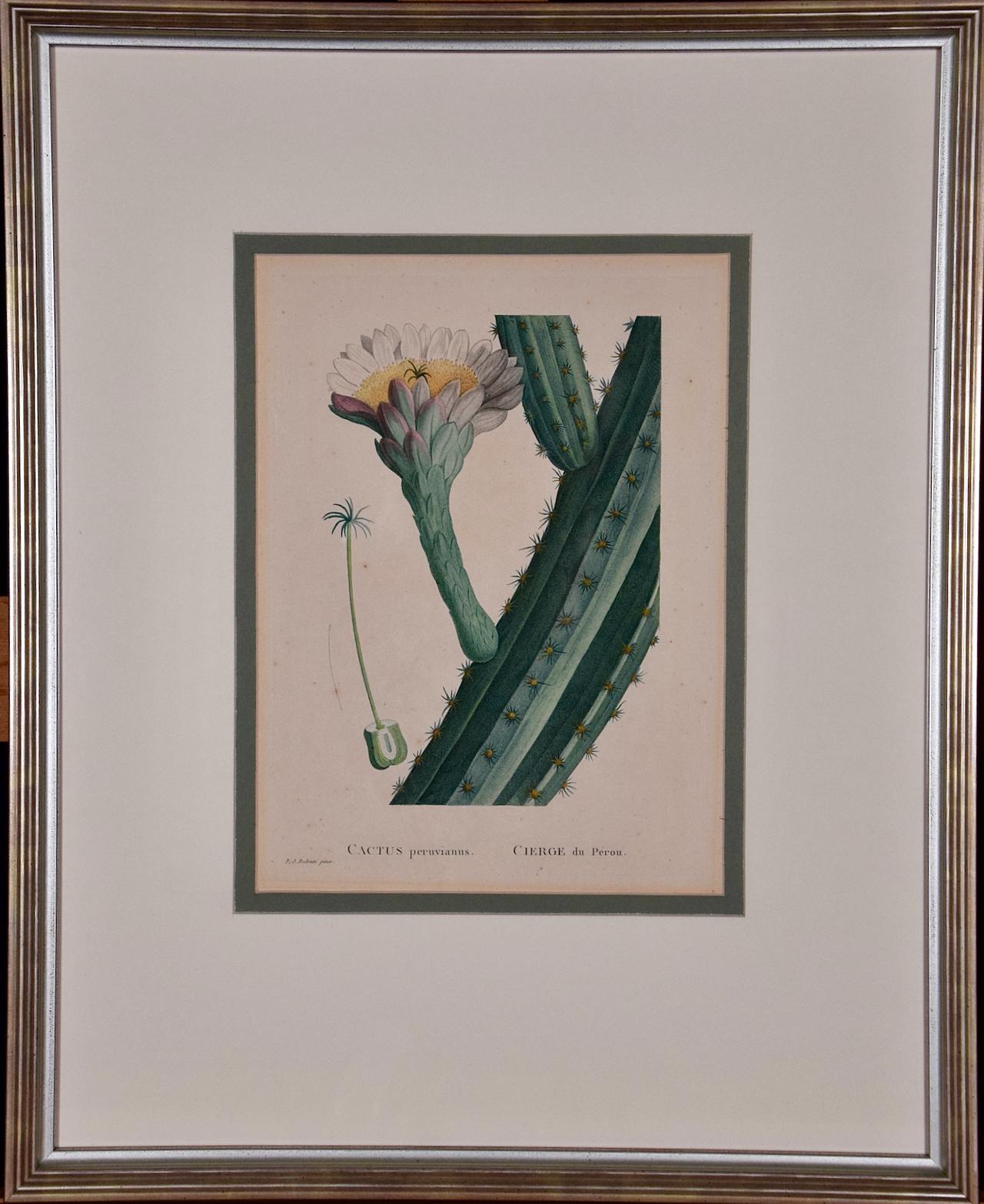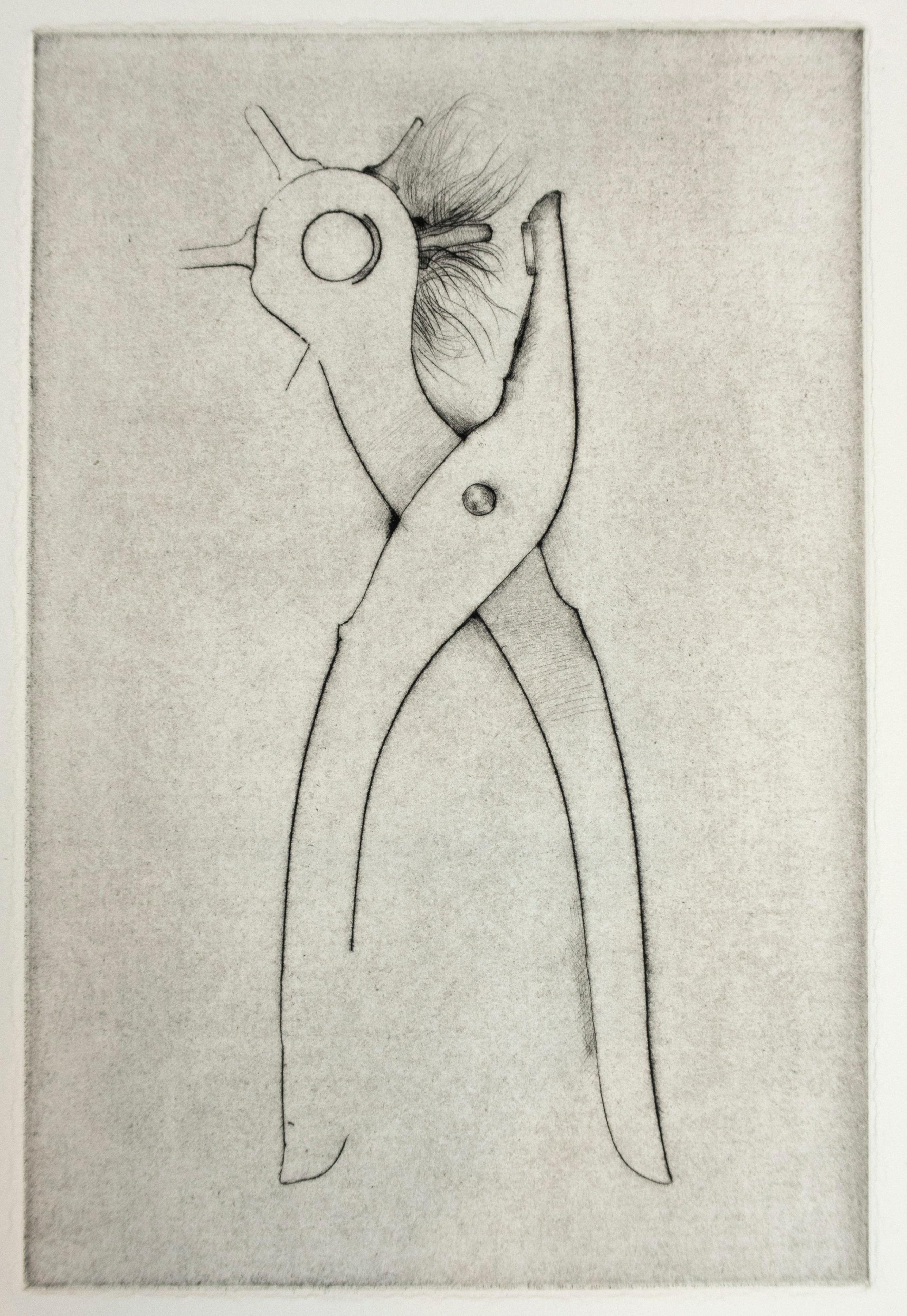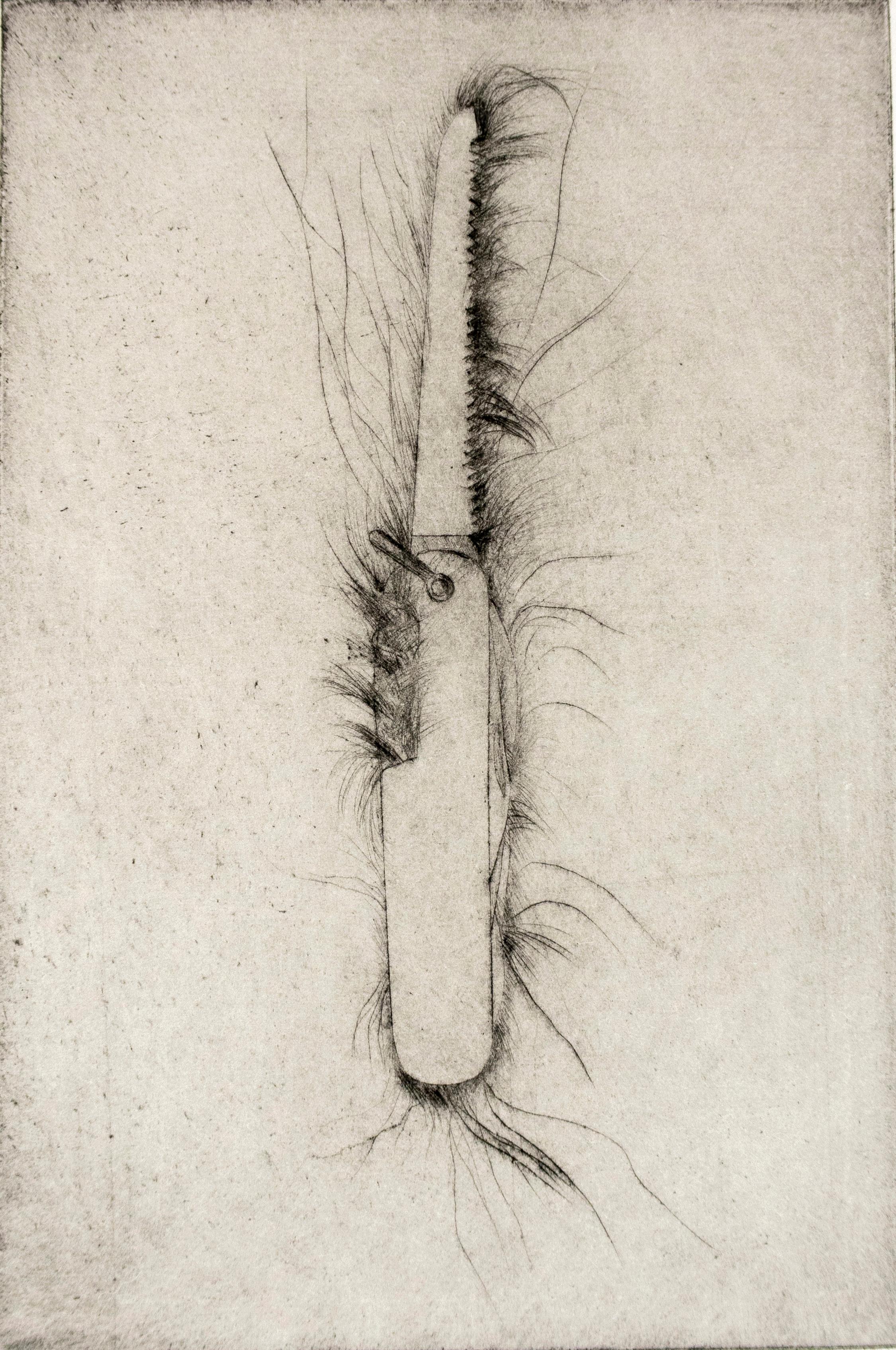Items Similar to Flowering Cactus: Redoute Hand-colored Engraving "Cactus Opuntia Polyanthos"
Want more images or videos?
Request additional images or videos from the seller
1 of 10
Pierre-Joseph RedoutéFlowering Cactus: Redoute Hand-colored Engraving "Cactus Opuntia Polyanthos"1799
1799
About the Item
This hand colored stipple engraving entitled "Cactus Opuntia Polyanthos, Cierge Raquette Multiflore" by Pierre-Joseph Redouté, Plate 59 from his illustrated publication 'Plantarum Historia Succulentarum ou Histoire des Plantes Grasses', published in Paris in 1799. Redoute was a pioneer of the stipple engraving technique, which he used to create this image. It involves utilizing a series of small dots worked into a copper plate rather than the more common lines. These dots can be made smaller or thicker depending on the degree of opacity the artist intends for various areas of the print. When inked and applied to paper, this allows for a greater portion of the paper to be seen, which accentuates the appearance of luminosity of the subject the artist is creating. Different color inks are used in the printing process, a time consuming technique known as "a la poupee". The engraving is then finished with watercolor to further enhance the beauty and realism of the print subject.
This engraving of a flowering cactus is presented in a double mat; white outer mat and heather green inner mat.The mat measures 20" x 16" and the sheet measures 19.5" x 13.38". There are wide margins with a few short tears and chips along the the right and upper edges, which are all covered by the mat. There are small spots predominantly in the margins, but a few are present in the image area, but the print is otherwise in very good condition. There is another Redoute flowering cactus listed on 1stdibs, LU117326854582. The pair would make an attractive display grouping.
Pierre-Joseph Redouté (1759-1840), was a painter and botanist originally from Belgium, who pursued his extremely successful artistic career in France. He is well known for his watercolor paintings of roses, lilies and other flowers and their subsequent folio-sized, color stipple engravings. Some believe him to be the greatest botanical illustrator of all time. Redouté was a favorite of the French royal court at the time and of the post French revolution aristocracy. He was an official court artist of Queen Marie Antoinette and his works continued to in demand during and after the French Revolution and Reign of Terror. He combined great artistic skills with a pleasing, ingratiating personality which assisted him with his influential patrons. After the fall of the French monarchy, he was a favorite Empress Joséphine, Napoleon Bonaparte's wife and later by his second wife Marie Louise, Duchess of Parma. The wife of Louis Philippe I, the last king of France, Maria Amalia of Naples and Sicily, was also a patron.
- Creator:Pierre-Joseph Redouté (1759 - 1840, French)
- Creation Year:1799
- Dimensions:Height: 21.25 in (53.98 cm)Width: 17.25 in (43.82 cm)Depth: 1.13 in (2.88 cm)
- Medium:
- Movement & Style:
- Period:
- Framing:Framing Options Available
- Condition:
- Gallery Location:Alamo, CA
- Reference Number:
About the Seller
5.0
Platinum Seller
These expertly vetted sellers are 1stDibs' most experienced sellers and are rated highest by our customers.
Established in 2011
1stDibs seller since 2019
233 sales on 1stDibs
Typical response time: 1 hour
- ShippingRetrieving quote...Ships From: Alamo, CA
- Return PolicyA return for this item may be initiated within 7 days of delivery.
More From This SellerView All
- Redoute Hand-colored Engraving of Cactus Flowers "Cactus Peruvianus Cierge"By Pierre-Joseph RedoutéLocated in Alamo, CAThis framed hand-colored stipple engraving entitled "Cactus Peruvianus Cierge du Pérou" by Pierre-Joseph Redouté, Plate 58 from his illustrated publication 'Plantarum Historia Succulentarum ou Histoire des Plantes Grasses', published in Paris in 1799. It depicts a branching limb of a cactus with a beautiful flower. There is a separate detail of the anatomy of a seed with early growth. Redoute was a pioneer of the stipple engraving technique, which he used to create this image. It involves utilizing a series of small dots worked into a copper plate rather than the more common lines. These dots can be made smaller or thicker depending on the degree of opacity the artist intends for various areas of the print. When inked and applied to paper, this allows for a greater portion of the paper to be seen, which accentuates the appearance of luminosity of the subject the artist is creating. Different color inks are used in the printing process, a time consuming technique known as "a la poupee". The engraving is then finished with watercolor to further enhance the beauty and realism of the print subject. This engraving of a flowering cactus is presented in silver-colored ribbed wood frame and a double mat; cream-colored outer mat and heather green inner mat. The frame measures 21.25" high by 17.25" wide by 1.13" deep. The sheet measures 19.88" high by 14" wide. There are wide margins with a few short tears and chips along the the left, right and upper edges, which are all covered by the mat. There are small spots predominantly in the margins, with a few present in the image area. The print is otherwise in very good condition. There is another Redoute flowering cactus listed on 1stdibs, LU117326853392, which is framed and matted identically to this one. The pair would make an attractive display grouping. Pierre-Joseph Redouté (1759-1840), was a painter and botanist originally from Belgium, who pursued his extremely successful artistic career in France. He is well known for his watercolor paintings of roses, lilies and other flowers and their subsequent folio-sized, color stipple engravings. Some believe him to be the greatest botanical illustrator of all time. Redouté was a favorite of the French royal court at the time and of the post French...Category
Late 18th Century Naturalistic Still-life Prints
MaterialsEngraving
- "Limon Straitus Amalphitanus" Ferrari 17th C. Hand Colored Engraving of LemonsBy Giovanni Battista FerrariLocated in Alamo, CAThis 17th century hand-colored engraving of a lemon entitled "Limon Straitus Amalphitanus" is Plate 249 from Giovanni Baptista Ferrari's publication "Hesperides, sive, De Malorum Aur...Category
17th Century Old Masters Figurative Prints
MaterialsEngraving
- Hand-colored 1834 Joseph Paxton Botanical Engraving of Yellow Trumpet FlowersBy Joseph PaxtonLocated in Alamo, CAA hand-colored engraving of yellow trumpet flowers from Sir Joseph Paxton's (1803-1865) "Magazine of Botany and Register of Flowering Plants", published in 1834. This engraving entit...Category
Early 19th Century Academic Figurative Prints
MaterialsEngraving
- Besler Hand Colored Botanical Engraving of Wood Pink & Cottage Pink FlowersLocated in Alamo, CAA 17th century hand-colored copper plate engraving entitled "Caryophyllus Maior Sylve Strisvarie Gatus" (Wood Pink & Cottage Pink Flowers) from Basilius Besler's landmark work, Hortus Eystettensis (Garden at Eichstatt), first published in 1613 in Eichstatt, Germany near Nuremberg and later in 1640 and 1713. This engraving is presented in a silver and gold-colored wood frame with a green edge and three elaborate cream-colored French mats...Category
17th Century Old Masters Figurative Prints
MaterialsEngraving
- A 19th century Colored Botanical Engraving of Flowers by CzeigerLocated in Alamo, CAA colored 19th century botanical engraving of flowers by Anstalt S. Czeiger of Vienna, Austria. An inscription at the bottom includes: "Wien, Kai...Category
Late 19th Century Academic Figurative Prints
MaterialsEngraving
- Pair of Hand-colored Romantic French Engravings after Francois BoucherBy (After) Francois BoucherLocated in Alamo, CAA pair of French classical romantic prints original created in the 18th century by Jacques-Firmin Beauvarlet (1731-1797) after paintings by Francois Boucher (1703-1770), utilizing ...Category
18th Century Romantic Figurative Prints
MaterialsEngraving, Etching
You May Also Like
- Heinrich Ulrich after Paul Mair, Guard of Emperor Rudolph, Soldier, LandsknechtLocated in Greven, DEHeinrich Ulrich (aka Heinrich Ullrich) (fl.1567–1621) “Soldier with Hellebarde”, 1598, out of the series, “The Guard of Emperor Rudolph” (aka “Old German Soldiers...Category
16th Century Renaissance Figurative Prints
MaterialsEngraving
- Maerten De Vos, Baptista Vrints, Christ Baptism, Engraving, Old MasterBy Maerten De VosLocated in Greven, DEMaerten de Vos after J Baptista Vrints Baptism Scene EngravingCategory
17th Century Renaissance Figurative Prints
MaterialsEngraving
- Tool Drypoint: Paintbrush by Jim Dine, black and white tool still life sketchBy Jim DineLocated in New York, NYJim Dine drew the plate for this image in the same period as his “Thirty Bones of My Body” 1972 portfolio of drypoint tool images. Crisbrook paper (30 x 22 in. / 76.2 x 56 cm.) and p...Category
1970s Modern Figurative Prints
MaterialsDrypoint
- Tool drypoint: Weed puller by Jim Dine, black and white tool still life sketchBy Jim DineLocated in New York, NYJim Dine drew the plate for this image in the same period as his “Thirty Bones of My Body” 1972 portfolio of drypoint tool images. Crisbrook paper (30 x 22 in. / 76.2 x 56 cm.) and p...Category
1970s Modern Figurative Prints
MaterialsDrypoint
- Hole Punch (Jim Dine 30 Bones of My Body portfolio) tool dry pointBy Jim DineLocated in New York, NYThe hand tool is undoubtedly Jim Dine’s most iconic motif. Meticulously catalogued in rows like scientific specimens or sketched individually, hammers, awls, brushes, saws and screwd...Category
1970s Pop Art Figurative Prints
MaterialsDrypoint
- Drypoint: Hand saw by Jim Dine, black and white tool still life sketchBy Jim DineLocated in New York, NYJim Dine drew the plate for this image in the same period as his “Thirty Bones of My Body” 1972 portfolio of drypoint tool images. Crisbrook paper (30 x 22 in. / 76.2 x 56 cm.) and plate size ( 9 x 6 in. / 23 x 15 cm.) are the same. This drypoint comes from the archive of the publisher Petersburg Press. Signed by the artist, numbered 7/10, and dated 1972 lower center in pencil. Edition 10: this impression 7/10. Here, the blade of a hand saw...Category
1970s Modern Figurative Prints
MaterialsDrypoint
Recently Viewed
View AllMore Ways To Browse
Hand Colored Engraving
Antique Hand Colored Engravings
Antique Hand Colored Engraving
Roses Engravings
Rose Engraving
Flower Engravings
Pair Engravings
Pair Of Engravings
Engravings With Flowers
Copper Engraving Plate
Pierre Royal
Hand Colored Botanicals
Hand Colored Botanical
18th Century Colored Engraving
Antique Colored Roses
Antique Copper Still
Antique Copper Stills
Copper Still Antique



